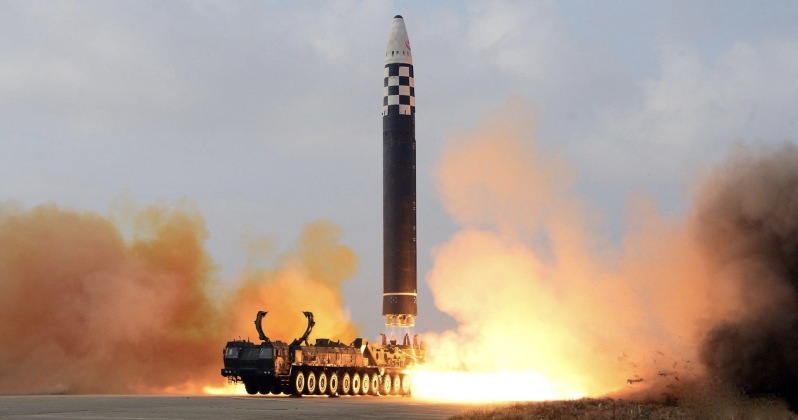Abid123
SENIOR MEMBER

- Joined
- Jan 1, 2021
- Messages
- 2,829
- Reaction score
- -8
- Country
- Location
On February 19 North Korean state media announced that the country had carried out a launch of a Hwasong-15 intercontinental range ballistic missile (ICBM) the previous day. The launch was carried out just days before the initiation of major joint military exercises in Korea by U.S. and South Korean forces simulating a war against the north. Pyongyang referred to the launch as part of “sudden launching drill” that furnished “actual proof” of its “fatal nuclear counterattack” capabilities, with the state run Korean Central News Agency emphasising that “the surprise ICBM launching drill” provided “clear proof of the sure reliability of our powerful physical nuclear deterrent.” Accordingly the exercise and launch were “suddenly organised without previous notice” after orders were given by the Chairman of the ruling Korean Workers’ Party, Kim Jong Un, for a simulated missile strike. The drill revealed the existence of North Korea’s Missile General Bureau, which is thought to be responsible for missile development, production and procurement, as well as operational support for existing missile units.

Hwasong-17 ICBM Launch
North Korea first demonstrated an intercontinental range nuclear strike capability in 2017, which was seen as key to deterring the United States from taking military action against it which was at the time under serious consideration. The country has since continued to quickly expand and modernise its arsenal. Demonstrating the ability to launch ICBM strikes quickly, and effective centralised command and control over the arsenal, provides an important indicator of the viability of the country’s nuclear deterrent. The Hwasong-15 was first test launched in November 2017, and was the first North Korean missile capable of reaching the American East Coast - where the preceding Hwasong-14 tested from July was only capable of targeting West Coast cities. The Hwasong-15 and much larger Hwasong-17, which was first unveiled in 2020, are thought to currently be in parallel serial production today. A further undesignated ICBM class using a solid fuel composite was unveiled earlier in February, and is expected to begin flightier testing within the next year.

U.S. Air Force B-29 Strategic Bombers Strike Korea in the Early 1950s
The ability to strike the American mainland is highly prized by North Korea, which remains in a state of war with the United States and has seen Washington consider large scale attacks including the launch of nuclear strikes against it on multiple occasions. President Barak Obama favoured an attack in 2016 and was reportedly deterred only by to severe warnings from the Pentagon, while his successor Donald Trump in 2017 drew up plans for mass nuclear attacks that were expected to kill millions of its population. The unprovoked strikes were almost initiated on both occasions, with North Korean retaliatory capabilities, and the Pentagon’s lack of intelligence on the locations of its leadership and weapons stockpiles, being key impediments in both cases. Previously nuclear attacks were very strongly considered by the Harry Truman, Dwight Eisenhower and Richard Nixon administrations, with the Lyndon Johnson and Bill Clinton administrations coming very close to launching non nuclear attacks on the East Asian state. An advanced missile deterrent, and nuclear warheads to serve as force multipliers for its missile strikes, are thus seen as a key guarantor of security by Pyongyang, with this lesson strongly reinforced by unprovoked American attacks against Libya and Iraq which had both surrendered their missile deterrents and weapons of mass destruction.
Source: https://militarywatchmagazine.com/article/north-korean-surprise-icbm-drill-hwasong15

Hwasong-17 ICBM Launch
North Korea first demonstrated an intercontinental range nuclear strike capability in 2017, which was seen as key to deterring the United States from taking military action against it which was at the time under serious consideration. The country has since continued to quickly expand and modernise its arsenal. Demonstrating the ability to launch ICBM strikes quickly, and effective centralised command and control over the arsenal, provides an important indicator of the viability of the country’s nuclear deterrent. The Hwasong-15 was first test launched in November 2017, and was the first North Korean missile capable of reaching the American East Coast - where the preceding Hwasong-14 tested from July was only capable of targeting West Coast cities. The Hwasong-15 and much larger Hwasong-17, which was first unveiled in 2020, are thought to currently be in parallel serial production today. A further undesignated ICBM class using a solid fuel composite was unveiled earlier in February, and is expected to begin flightier testing within the next year.

U.S. Air Force B-29 Strategic Bombers Strike Korea in the Early 1950s
The ability to strike the American mainland is highly prized by North Korea, which remains in a state of war with the United States and has seen Washington consider large scale attacks including the launch of nuclear strikes against it on multiple occasions. President Barak Obama favoured an attack in 2016 and was reportedly deterred only by to severe warnings from the Pentagon, while his successor Donald Trump in 2017 drew up plans for mass nuclear attacks that were expected to kill millions of its population. The unprovoked strikes were almost initiated on both occasions, with North Korean retaliatory capabilities, and the Pentagon’s lack of intelligence on the locations of its leadership and weapons stockpiles, being key impediments in both cases. Previously nuclear attacks were very strongly considered by the Harry Truman, Dwight Eisenhower and Richard Nixon administrations, with the Lyndon Johnson and Bill Clinton administrations coming very close to launching non nuclear attacks on the East Asian state. An advanced missile deterrent, and nuclear warheads to serve as force multipliers for its missile strikes, are thus seen as a key guarantor of security by Pyongyang, with this lesson strongly reinforced by unprovoked American attacks against Libya and Iraq which had both surrendered their missile deterrents and weapons of mass destruction.
Source: https://militarywatchmagazine.com/article/north-korean-surprise-icbm-drill-hwasong15
